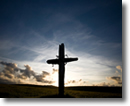 Good
Friday: Crucifixion
Good
Friday: Crucifixion
Called “good” because of all the wonder and meaning that flowed from it,
this is the day when Jesus was handed over to trial, tortured, forced to carry
his cross (a Roman tool for executing criminals) through the streets of
Jerusalem, nailed to the cross on the hill known as Golgotha, or Calvary, and
allowed to die a slow and agonizing death there, while crowds mocked him and his
disciples hid in fear.
All four Gospels tell this story in such detail that traditions have
arisen concerning the “Stations of the Cross,” describing Jesus’ journey from
trial to death, and his “Last Words from the Cross,” describing what Jesus said
while dying. Among other things, he asked forgiveness for those killing him.
According to the Gospels, only his mother Mary and the beloved disciple John
stayed near the cross. Other followers went into hiding. As Jesus died, even the
mocking crowds grew silent, and a Roman centurion was so moved by Jesus’
forgiveness from the cross that he was heard to say, “Certainly this man was
innocent.” (Luke 23.47) Another witness heard the centurion say, “Truly this man
was God’s Son!”
After Jesus died —a three-hour dying, according to tradition— his body was taken down from the cross and placed in a tomb owned by a wealthy man named Joseph of Arimathea and a heavy stone rolled into the tomb’s mouth. It was this tomb that was found empty on the third day.
Worship on Good Friday typically is somber, with no flowers, minimal vestments, sometimes a three-hour service of prayers and readings timed to coincide with Jesus’ presumed time on the cross. In Eucharistic churches, this is the one day of the church year when the Eucharist isn’t celebrated, although communion can be administered from reserved sacrament.
Copyright © 2007 Tom Ehrich